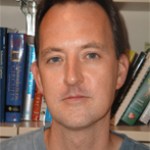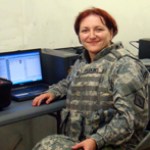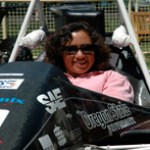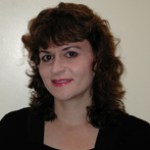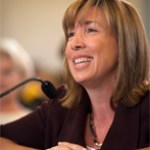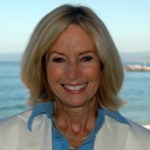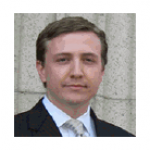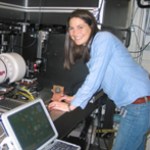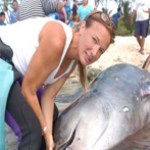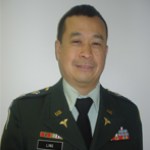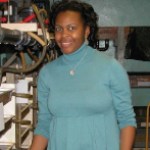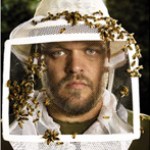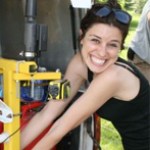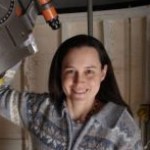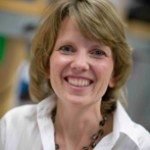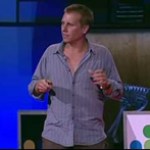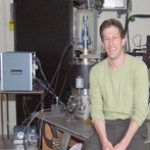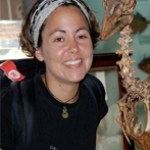
Electrical engineer and neurosciences researcher Charles Higgins sees a time in the future when scientists will design robots that have the powerful vision of a moth or dragonfly, or even have such insects built in them directly to carry out phenomenal tasks involving sight and motion detection. Science fiction, you say? While Charles does admit to a healthy penchant for such flicks as Star Trek, Terminator, The Matrix and Source Code, his cutting-edge research today is steadily turning insect-inspired robotics into reality -- work that is helping scientists harness and apply the electrical…
Born in the Eastern European province of Transylvania (known as the birthplace of Count Dracula), microbiologist Dana Perkins was raised in the former communist country of Romania and humorously describes herself as an "American by choice and vampire by birth." She chose microbiology as a field of study to understand what makes germs tick and how we can treat the diseases they cause.
Dana's love for microbiology has its roots in her childhood. "My mother was a nurse, so I spent a lot of time doing my homework in her medical office while waiting for her to finish her duties each day," says…
We've all heard the news: U.S. students aren't pursuing engineering careers in sufficient numbers to keep pace with the technical demands that our global markets will require for the future. So where do we start in turning this situation around? The answer is really quite basic, according to Celeste Baine, director of the Engineering Education Service Center (EESC) and the award-winning author of more than 6 publications on motivating and educating students towards engineering careers. "We've got to start communicating and demonstrating to students how important engineering is in…
Karen Panetta sometimes has to laugh at the way engineers are portrayed in drawings by young students at the schools she visits. The children's crayoned pictures usually depict boorish, geeky male stick figures wearing glasses; some of them have buck teeth and pimples, "and they're most always carrying wrenches," says Karen. Such are the musings of children, you might say, but Karen, an electrical and computer engineering professor at Tufts University in Medford, MA, is out to dispel such stereotypes at an early age in kids. "If you think being an engineer is sitting around being boring, you…
As deputy administrator of NASA, Lori Garver is NASA's second in command. She works closely with its administrator to provide leadership, planning, and policy direction for the agency. Together they represent NASA to the Executive Office of the President, Congress, heads of government agencies, international organizations and external organizations and communities. She also oversees the work of NASA's functional offices.
Lori's confirmation as deputy administrator marks the second time she has worked for NASA. Her first period of service to the agency was from 1996 to 2001. She first served…
Metals have often been overlooked as a viable field for innovation, but materials scientist Ainissa Ramirez is helping to change that. Her groundbreaking research has resulted in new ways to control and shape metals into materials that can be put to practical everyday use - from producing stronger circuitry for cell phones to developing more efficient medical devices that save lives. "The diverse applications of these metals have made them increasingly important and visible to the world," says Ainissa, associate professor of Mechanical Engineering at Yale University where research on shape…
Overseeing the U.S. Geological Survey (USGS) - the country's largest water, earth and biological scientific and civilian mapping agency -- seems a natural fit for Marcia McNutt. She's a Navy Seals-trained underwater demolition and explosives expert, earthquake scientist, avid lover of the ocean -- and a leading geophysicist who brings vast academic and scientific background to her post.
As the first woman director of the USGS in the agency's 131-year history, Marcia was nominated to the post by President Obama in 2009 and later approved by the Senate to head USGS's mission of serving as…
A new age is dawning in U.S. space exploration: Entrepreneurs such as Richard Branson, Elon Musk, and Jeff Bezos, are working to open up human spaceflight, once the domain only of governments, to the private sector and the public. Soon, anyone will be able to go to space just by purchasing a ticket on a suborbital space flight, and several companies are working on orbital space missions as well. Scientists, teachers, artists, and even kids will travel to space by the thousands and experience the wonder of weightlessness and seeing the Earth from above.
"These companies are bringing the…
In her laboratory, scientist Elizabeth "Liz" Cottrell uses sophisticated equipment to simulate the extreme conditions found deep below volcanoes - creating pressures equivalent to the center of the Earth and temperatures hotter than the sun. Her experiments at the micron scale are shedding light on the processes that have shaped our planet.
Liz is a geologist at the Smithsonian Institution's National Museum of Natural History where she directs its Global Volcanism Program as well as serving as a curator and research geologist in the Department of Mineral Sciences. Her research involves…
The humpback whale - 25 to 40 tons of pure majesty in motion. That's how most of us would describe these compelling, formidable animals if we were lucky enough to observe them as they languidly follow their migration routes. Noted conservationist Nan Daeschler Hauser is indeed one of the lucky ones. Working from her remote research base in the remote South Pacific island of Rarotonga in the Cook Islands, she studies the humpback and other whale species, including their populations and the migratory habits they follow for food, mating and calving.
From her base in Rarotonga, Nan serves as…
The human hand - four fingers and a thumb. When we lose it due to injury, we've lost something that truly makes us human. That's a key reason why the Pentagon's "Revolutionizing Prosthetics" program, a $100 million multi-disciplinary effort in science and engineering is so important. It is working towards building a robotic arm with a fully functioning hand -- a feat never before accomplished in medicine.
The need for such a development is accentuated by the number of wounded soldiers returning home after service in Iraq and Afghanistan, many having suffered the amputation of their arm. "We…
If there is one piece of advice that marine biologist and Nifty Fifty Speaker April Croxton would give young students aspiring to pursue a career in science it would be: Don't narrow down your career choice in science too early. "Science is so vast an area, encompassing so many disciplines, some of them often intersecting and crossing over to other areas that also may be appealing to you," says April, a fishery biologist at the National Marine Fisheries Service of the National Oceanic and Atmospheric Administration (NOAA) in Milford, CT. "Take time to explore and study as many areas of…
Bees represent some of the most resilient, adaptable and enterprising insects on earth. Not only that, they pollinate about one-third of all the food we eat. So when honey bees began dying or disappearing at alarming rates in the U.S. and around the world more than four years ago, scientists such as Nifty Fifty Speaker Dennis vanEngelsdorp, as the acting Pennsylvania state apiarist (beekeeper) and one of the nation's most prominent advocates and researchers of bees, was naturally deeply concerned. "Bees and other pollinators are a barometer and referendum on the state of our environment,"…
It is well after 1 a.m. on May 11, 2010. Karen Kosiba, a post-doctoral scientist for the Center for Severe Weather Research (CSWR) in Boulder, CO, takes a breather in her Doppler on Wheels weather research vehicle in Perry, Oklahoma, a rural town 60 miles north of Oklahoma City. She and her fellow CSWR scientists are bone-weary after spending previous hours in the region chasing a major outbreak of tornadoes- - a spate of wicked weather that ultimately spawned more than 60 tornadoes over a three-state area, claiming three lives in Oklahoma and causing more than $595 million in damage in the…
Like the stars she studies, Nifty Fifty Speaker and astrophysicist Maura McLaughlin has reached some lofty heights in her young career as she works to shed further light on the Universe and the physical laws governing it, including Einstein's theory of relativity. Maura is an assistant astrophysics professor at West Virginia University where her work mainly involves researching neutron stars - burned out remnants of stars known as pulsars that are formed in supernova explosions following the collapse of massive evolved stars.
"These exotic objects are more massive than the Sun, and can spin…
Nifty Fifty Speaker Carl Zimmer is often called one of the nation's most astute, informed and lyrical science writers. Specializing in communicating about the wonders and mysteries of evolution, biology and neuroscience, Carl Zimmer - in such books as The Tangled Bank, Parasite Rex, and Soul Made Flesh - writes with such grace, skill and clarity that he makes even difficult subjects like natural selection and the brain understandable and exciting to readers who have little formal education in science.
"I like to write books about subjects that greatly intrigue me --subjects that I want to…
Like a detective on the hunt, researcher and Nifty Fifty Speaker Sarah Fortune is trying to figure out how Mycobacterium tuberculosis - the bacterium that causes tuberculosis (TB)
- is able to defend itself so well against drug treatment and the body's immune
system.
The challenge is a daunting one. As much as one-third of the world's population
is infected with Mycobacterium tuberculosis, yet relatively little is known about
how the organism manages to persist for so long, sometimes for decades, in so
many people.
Though tuberculosis can be fatal, in most cases the immune system controls…
Published Science Journal Authors at Eight Years of Age? It Happened in the Blackawton Bees Project!
What would you say if a group of primary school children achieved the unprecedented task of having their school research project accepted for publication in an internationally recognized peer-reviewed science journal?
"Unbelievable," you would probably retort. But that's what happened when a cadre of 25 eight to ten year-old British students participated in an innovative hands-on undertaking in science education headed by Nifty Fifty Speaker Beau Lotto, founder and director of Lottolab, a cutting-edge science laboratory and art studio based at University College London's Institute of…
Meet physicist Andrew Zwicker who is working to raise the status of plasmas in science education. A plasma physicist by training, Andrew is Head of Science Education at Princeton University's Plasma Physics Laboratory (PPPL) where he spends much of his time introducing high school students, undergraduates and K-12 teachers to the glowing, ionized gases that make up plasmas, and to the important role plasmas play in science.
"Plasmas are hot gases containing a significant number of electrically charged particles, and are common in nature," says Andrew, "as exemplified by lightning, the solar…
Meet Nifty Fifty evolutionary biologist Beth Shapiro who spends her days peering into the past. Her work in the emerging research field of ancient DNA takes her on a fascinating journey through time - collecting and studying the genetic samples of giant mammoths, saber-toothed cats, mastodons, dodo birds and other extinct animals, and piecing together such mysteries as the last ice age and the arrival of the first humans to North America.
"Ancient DNA gives us new insight into the most fundamental processes of evolution and refreshing new information about our past," says Beth, assistant…
